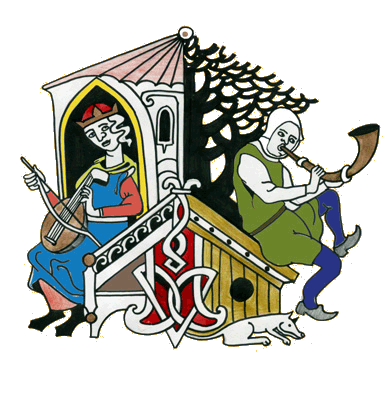
Kings & Beggars - Gryphon (2018)
The gryphon, a legendary creature from ancient myths,not accidentally has become the symbol of our jubilee album. Just as a gryphon is a combination of a lion and an eagle, so our album contains music of different times and nations, ours and yours favorite songs and melodies. Enjoy this travel thru time and countries with us!released November 17, 2018
Anna Vasylchenko - medieval fiddle, recorders, litvinian shawm, vocals, galician gaita.
Marta Hovdysh - hurdy-gurdy, recorders, vocals.
Max Kerner - bouzouki, saz.
Yevhen Grinevich - recorders, medieval shawm, vocals.
Artur Temchenko - tambourins, tar, daf, medieval drum, darbuka, zills.
Guest musician: Vera Brenner - vocals (12, 13), dudelsack (12).
Kings & Beggars - Rosa das Rosas (2018)
XIII century Castilian court was known as a science and art centre from Pyrenees to the Alps. Musicians, dancers and singers drove to the court of Alfonso X the Wise, and not only Christians but also people of other believes. We want to show this educated multicultural society of those old times.released February 3, 2018
Anna Vasylchenko - medieval fiddle, recorders, shawm, vocals.
Marta Hovdysh - hurdy-gurdy, recorders, vocals.
Max Kerner - bass citole, oud.
Yevhen Grinevich - recorders, medieval shawm, vocals.
Artur Temchenko - tambourins, tar, daf, medieval drum.
Guest musician: Anton Korolev - tarota.
Kings & Beggars - Rota Fortunae (2015)
From ancient times Wheel of Fortune holds not the last place in symbolism and is extremely relevant in our time. A turn of Wheels of Fortune knows no mercy, it symbolizes the great global rotation, which has no payoff in advance for anybody - all men are equal. Anyone who is now at the top tomorrow will be humbled; one who is now at the bottom, tomorrow gets up to the top.Wheel of Fortune, in its cosmic aspects represents the idea of cyclical time, as opposed to linear time; it is the embodiment of eternal cycle of life, a symbol of world order. In the architecture it was represent as gothic rose.In Rome fate was called Fortune and had the same meaning. Later, in Christian times, Fortune was perceived as happiness and unhappiness as two forces that affect a person: light - angel behind the right shoulder, and dark - devil, looking out of the left shoulder.
In the early centuries of the Middle Ages image of Fortune in popular culture became more close with Germanic notions of destiny, which included "happiness" and "unhappiness", "success" and "failure", "fate" and "luck." This convergence is reflected in the heroic epic and skalds poetry. Winged Fortune served as a prototype of Christian angels.
Fortune took a special place in the culture of the West European High Middle Ages. We find her figure in medieval manuscripts in verses of troubadours and vagants; even medieval jurists applied interpretation of Fortune in legal incidents, not to mention the fact that Fortune - one of the favorite themes of medieval philosophy.
Symbol of Wheel of Fortune was reflected in many medieval treatises, "Carmina Burana" among them also known as the "Codex Buranus" - an illustrated manuscript of the XIII century, a handwritten poetry collection (currently located at the National Library of Munich).
Name of the manuscript in Latin means "Songs of Boyern" (the manuscript was found in 1803 in medieval monastery Beuern, now in Benediktbeuern, Bavaria). This is the largest known collection of vagants poetry made in southern Germany in the XIII century; it has 315 texts of various sizes.
"Rota Fortunae" (Wheel of Fortune) album is based on lyrics from this manuscript.
Kings & Beggars - Breve Regnum (2014)
This EP was created as a gratitude for people who supported creation of this video Breve RegnumViter and Kings & Beggars - Diva Ruzha (2011)
All songs on current CD have traditional roots but they will appear in completely different form. Songs were performed in four languages - Ukrainian, Swedish, Latvian and Breton. Music for “Migla, Migla, Rasa, Rasa” was written by SKYFORGER, lyrics - traditional.This album is quite experimental in many ways. The main conceptual point of the current work was an attempt to integrate such things as Carpathian folklore with a Swedish native song, to perform European traditional music by means of medieval instruments with appropriate arrangement; and at last to present an unexpected sounding of all these compositions.
The work over the album was performed in three recording studios during Autumn 2010 - Winter 2011. None of the keyboards and samples were used in the recording process - dozens of various traditional and medieval instruments (precisely - 35) were recorded live.
Unique handmade instruments made by VITER members - Heracleum horns were used in a title song. They are 3 meters long thus 3 times wider then common Ukrainian Trembita.
Professional artist Yuriy Koval, known for his portrait artworks for the first two KRODA albums worked over the album cover.
"Diva Ruzha" recorded at Viter studio, Ukraine, 2010. Mixed and mastered in dB Recordings, Slovenia, 2011.
"Ai Vis Lo Lop" and "Migla, Migla, Rasa, Rasa" recorded at Max 220 studio, mixed and mastered in Ukraine, 2010-2011.
"Vanner Och Frander" recorded, mixed and mastered at Viter studio, Ukraine, 2010-2011.
"Chycheri" recorded, mixed and mastered at Viter studio, Ukraine, 2011.

Kings & Beggars - Live at Tustan' festival (2009)
1. Kastarvat2. Villanella
3. Bourree (music by Stary Olsa - "Pahod")
4. Courage
5. Frog Galliard
6. Slip Jig
7. Irish polka
8. Kesh Jig
9. Saltarello
Total time: 22:13
Download